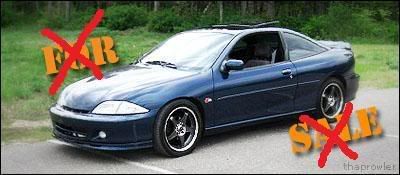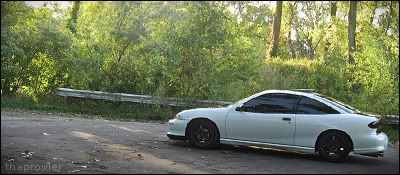i was wondering if any one on the Org. has an electric water pump on their street or race vehicles. Does anyone know how many GPM the stock 2.4 ld9 engine mechanical water pump flows? I am looking into this. I know it will free up mechanical power. possibly not a lot of power. I know that flow changes in a mechanical with Rpm and an electric one stays constant but i have also seen in other forums that people have a variable electric water pumps. The safety measures i have heard are that people would install dummy lights if the pump were to fail and would carry another electric pump. the pumps location would be in an easy to change remote location. so far from what i heard in other forums that many people do run them on street cars and have had no problems. Some run them for their weekend cars and some as a daily driver. Here is a link to one of pumps that people seem to be interested in. well this one and Meiziere.
http://www.daviescraig.com.au/main/display.asp?pid=47
heres another people where using on the mopar engines
http://www.cvrproducts.com/proflo_chrysler.html
The 2.4 water pump is driven off of teh timing chain. If you convert to an electric pump you will have to solve the timing chain issue.

YEs you can either run a dummy sprocket. and cover up the whole or shorten the chain.
Or just leave it alone and not worry about other potential issues.

well we could have left cams alone and not worry about potential issues or other engine internal mods. but i guess we didnt. so i see no point if anyone knocks on anyone for thinking of future potential mods. besides its an idea. i would be able to design something like this. i have worked with catia solid works and autocadd. ive taken engine design both in junior and at a university. im sure i can find my way around this im just wondering if anyone has done this. and can give me info on GPM of the stock mechanical LD9
There was a belt drive "kit" offered in limited quantities for the Q4 that eliminated the mechanical WP, but it also made some huge changes to how teh timing setup was.

its not a problem on the q4 cus the pump drive gear is not attached to the pump itself..its pressed into the the timing housing and can just sit there and free spin without altering the chain...if you can press a q4 pump drive gear into a 2.4 timing housing i think it would be more doable..anyone wanna give it a shot?

I do believe that the bearing is pressed into a boss that is part of teh housing casting. If that is teh case it would be a giant PITA to retrofit into a 2.4 housing. Possibly swap to a older Q4 housing and double row chain?

i would just leave @!#$ as it is and spend your money on something better than that bull@!#$.
Interesting thread and listening.
I've had ideas of this too but always had that issue of the timing chain driven off of the waterpump.
Listening.
Misnblu.com
Newbie member since 1999
Thank you Dave and JBO! 

MadJack wrote:If I were to run an electric water pump on the LD9, I'd gut the pump(remove the impeller and use one of Summit Racing's universal electric water pumps in line between the motor and the radiator. I fit does fail, it would be the easiest to replace. Me personally, I'd only use one on a track only car.
Hey, that's what I was thinking of for an experiment in fuel mileage gains. The idea was that the pump would remain off until the in-block coolant temperature fully reached the thermostat opening point, then have it switch on until it saw the temp drop to a set point. The goal is to acheive faster warm-up & maintain optimal engine operaitng temperature, so as to reduce fuel consumption due to less than optimal engine operating temps. Hopefully I'll get to do it someday. And when I do, I'll be right back here (And on the S-truck forum I subscribe to) with the results. Wish me luck!
Go beyond the "bolt-on".
Doing something like this seems pointless, very costly, and time intensive. I can not see any benefit whatsoever to doing this.

FORGET GIRLS GONE WILD WE HAVE GOVERNMENT SPENDING GONE WILD!
Wade Jarvis wrote:Doing something like this seems pointless, very costly, and time intensive. I can not see any benefit whatsoever to doing this.
having an electric water pump would allow me to run a belt drive timing conversion........so


Wade Jarvis wrote:Doing something like this seems pointless, very costly, and time intensive. I can not see any benefit whatsoever to doing this.
I already stated why I'd make such a conversion. I've even made comment on how such a device would be handy when used with a tank heater & battery charge maintainance device during cold, overnight storage (See: Electric P/S Pump). If you don't see the point, tell us why... instead of just condemning it coldly.
Go beyond the "bolt-on".
MadJack wrote:Wade Jarvis wrote:Doing something like this seems pointless, very costly, and time intensive. I can not see any benefit whatsoever to doing this.
This is done to reduce the amount of parasitic power loss. The faster you turn the motor, the more resistant the pump flow becomes, till you reach a point of cavitation. Just about all mechanically/engine driven water pumps will reach a point of cavitation, then you are no longer moving any water to cool the engine, or you move the water through the engine too fast to absorb any heat. Either problem isn't good for an engine being pushed hard.
With an electric pump, you get a consistent flow rate, no parasitic power loss and the cooling range is more easily controlled with electronic control devices, such as adjustable or fixed thermostatic switches, Tic-Toc device, PCMs, etc....
SO that would explain why my coolant temps would plummet during extended periods above 7000 RPM, maybe. I do have to admit that 7500 sounds very nice in a 2.4. I do miss that sound and feeling.

Something else that must be kept in mind when dealing with factory water-pumps is that sometimes the factory or the replacement-part manufacturer "chinzes" on the quality of the the impeller design, resulting in a paump that's barely that effective in moving water at even low speeds. A well designed impeller, especially one designed for high-speed engine operation, will prevent this & do a much more effective job in cooling the engine. But still, much like with the old arguement of replacing the thermostat with a large washer, if the coolant flow flow-rate is too high then the coolant won't have a chance to effectively absorb the heat & properly cool the engine.
Hmmm... I wonder what could result if an electric waterpump w/thermostatic controller was combined with a washer in place of the thermostat?
Go beyond the "bolt-on".
That's what I was thinking... It'd be way more effective at controling engine temp than the old rodder's trick of using a washer as a restrictor in conjunction with a mechanical pump.
Go beyond the "bolt-on".
MadJack wrote: With an electric pump, you would still want to use a flow restictor (,big washer or punched out thermostat) in place of the thermostat. It adds resistace to the flow out of the block, so the water is held against the hot surfaces long enough to absorb the heat from the motor.
No you wouldn't, not with our water system. Our water system recirculates 100% of the time through the head and back to the pump...All you would need to do is replace an electric water pump in-place of the mechanical one and turn it on...that's it.
<table>hello</table>
the fact that you wouldn't need to tear down half the g'damn engine to change the water pump is enough in itself to do a conversion. especially since the water pumps go without notice on a regular basis... especially on cars that regularly see high rpm's and lead foot activity.


+

+

+

+

+

+

+

+

+

+

=

maybe a 1.5 hour job.

After a few bad MLS gaskets in a row you can get quite fast at tearing the timing set down.
















